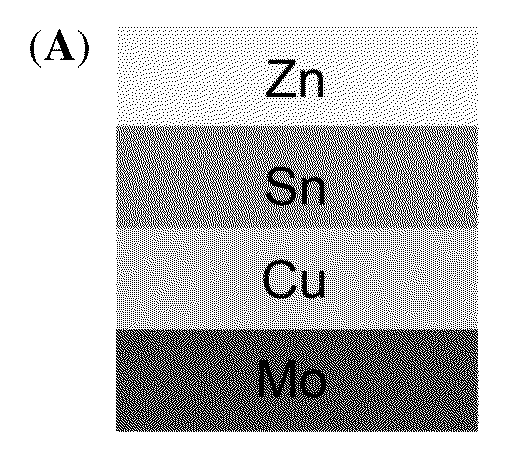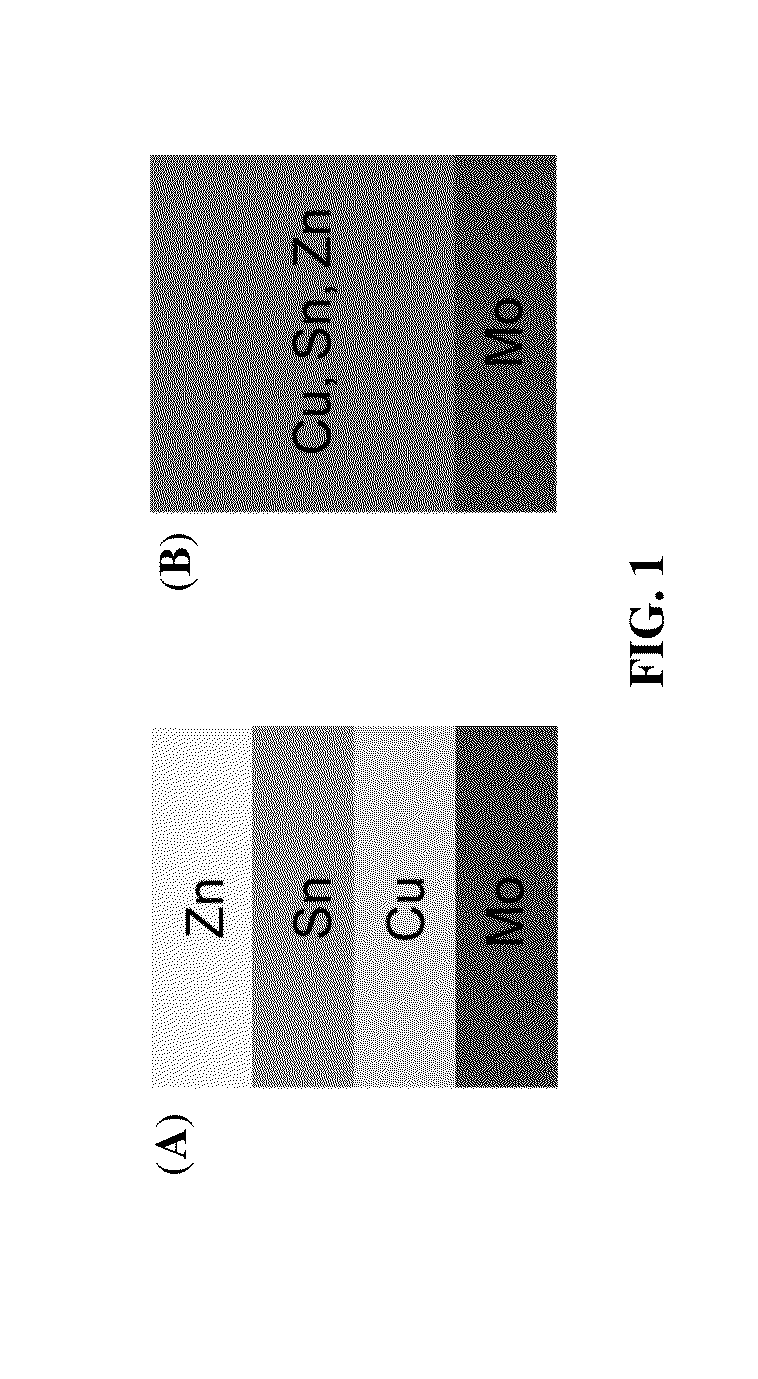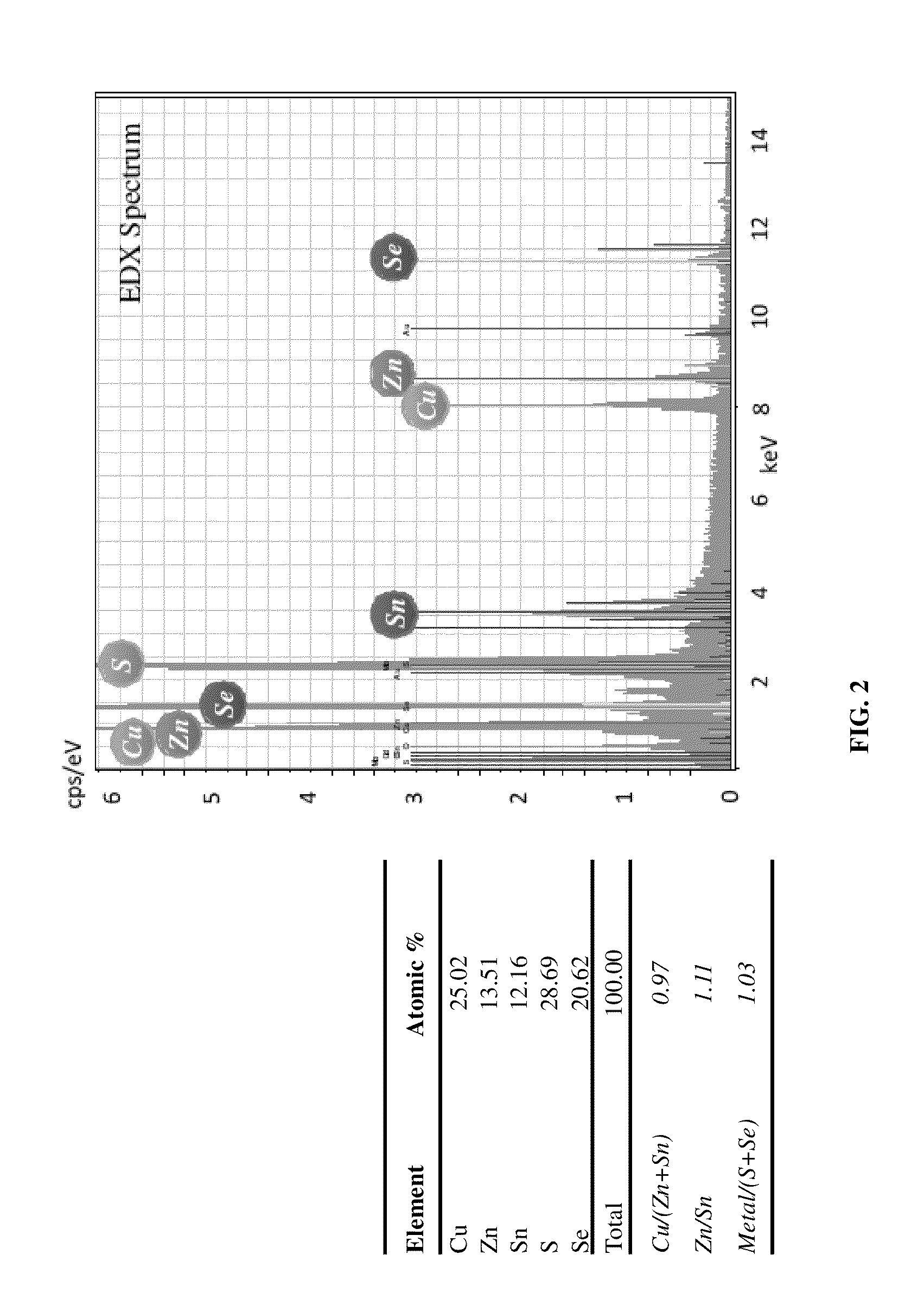Non-vacuum method of manufacturing light-absorbing materials for solar cell application
a technology of solar cells and light-absorbing materials, which is applied in the direction of coatings, surface reaction electrolytic coatings, semiconductor devices, etc., can solve the problems of high cost, high cost, and high cost of deposition techniques (e.g. evaporation and sputtering), and achieve good conversion efficiency and simplified fabrication of light-absorbing layers.
- Summary
- Abstract
- Description
- Claims
- Application Information
AI Technical Summary
Benefits of technology
Problems solved by technology
Method used
Image
Examples
example 1
Formation of Cu—Zn—Sn Alloy by Single-Bath Formulation
[0038]In this example, a Cu—Zn—Sn alloy is prepared by a single-bath formulation containing a plating composition. An exemplary plating composition is provided in Table 1.
TABLE 1UpperLowerPlating parameterUnitLimitLimitPlatingMain bathSalts of Citrate (include sodium citrate,mM100500Compositionpotassium citrate, mono- / di- / tri- basic)Cu salt (e.g. CuCl2, CuSO4, Cu(NO2)2)mM1050Sn salt (e.g. SnCl2, SnSO4, Sn(NO2)2)mM540Zn salt (e.g. ZnCl2, ZnSO4, Zn(NO2)2)mM50300AdditivesSurfactant (e.g. Sodium dodecyl sulfateg / L110(SDS), N,N-Dimethyl-N-dodecylglycine betaine (EMPIGEN ®BB), Polyethylene glycol (PEG))Aldehyde based compounds (e.g.g / L0.14propenal, aromatic aldehyde,benzaldehyde, formaldehyde)
[0039]Besides the ionic compounds of copper, zinc and tin, the plating composition also includes salts of citrate to stabilize the plating solution and additives such as surfactant and aldehyde based compounds to reduce the surface roughness. Opti...
example 2
Sequential Sulfurization and Selenization of Cu—Zn—Sn Alloy
[0042]An annealing step is required to transform a Cu—Zn—Sn alloy to CZTS light absorbing layer. Annealing conditions for sulfurization and selenization are illustrated in Table 2:
TABLE 2UpperLowerParametersUnitLimitLimitSulfurizationTemperature° C.350600Durationmin30200Ramp rate° C. / min0.22SelenizationTemperature° C.300550Durationmin230Ramp rate° C. / min0.53
[0043]Flow diagram from formation of Cu—Zn—Sn alloy to annealing is shown in FIG. 4: 401: Formation of Cu—Zn—Sn alloy by co-plating of a single-bath formulation on molybdenum (Mo) substrate; 402: Formation of sulfur-rich atmosphere by using inert carrier gas flowing over sulfur; 403: Formation of Cu—Zn—Sn—S alloy after first annealing; 404: Formation of selenium-rich atmosphere by using inert carrier gas flowing over selenium; 405: Formation of Cu—Zn—Sn—S—Se alloy after second annealing. A schematic diagram summarizing the sequential sulfurization and selenization on the ...
example 3
Formation of Selenium Layer on Alloy Substrate
[0044]It is preferable to electroplate a selenium layer before annealing any alloy substrates under selenium-rich atmosphere. An exemplary plating composition for electroplating the selenium layer is provided in Table 3.
TABLE 3UpperLowerPlating parameterUnitLimitLimitPlatingMain bathMetra-alkyl-quaternary ammonium salt%2060Composition(e.g. choline chloride, betaine, acetylcholine chloride, methyl triphenylphosphunium bromide,tetrabutyl ammonium chloride)Selenium compounds (e.g. seleniummM5100tetrachloride, selenium dioxide,selenium sulfide, selenium oxychloride,selenous acid, and selenic acid)AdditivesSurfactant (e.g. Sodium dodecyl sulfateg / L0.54(SDS), N,N-Dimethyl-N-dodecylglycine betaine (EMPIGEN ®BB), Polyethylene glycol (PEG))Aldehyde based compounds (e.g.g / L0.52propenal, aromatic aldehyde,benzaldehyde, formaldehyde)
[0045]A solvent containing one or more than one kind of tetra-alkyl-quaternary ammonium salt as the major component, a...
PUM
| Property | Measurement | Unit |
|---|---|---|
| pH | aaaaa | aaaaa |
| temperature | aaaaa | aaaaa |
| pH | aaaaa | aaaaa |
Abstract
Description
Claims
Application Information
 Login to View More
Login to View More - R&D
- Intellectual Property
- Life Sciences
- Materials
- Tech Scout
- Unparalleled Data Quality
- Higher Quality Content
- 60% Fewer Hallucinations
Browse by: Latest US Patents, China's latest patents, Technical Efficacy Thesaurus, Application Domain, Technology Topic, Popular Technical Reports.
© 2025 PatSnap. All rights reserved.Legal|Privacy policy|Modern Slavery Act Transparency Statement|Sitemap|About US| Contact US: help@patsnap.com



